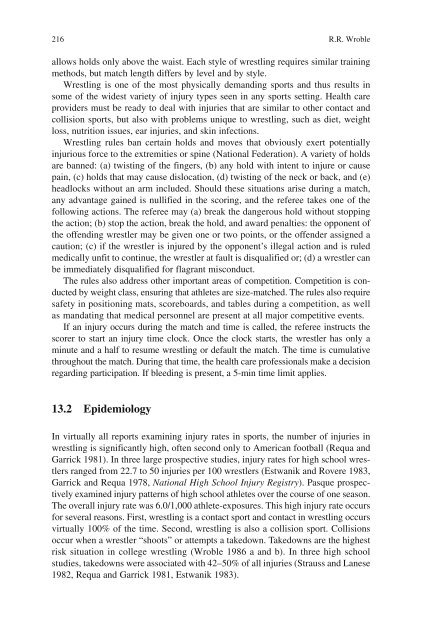Nutrition in Combat Sports
Nutrition in Combat Sports
Nutrition in Combat Sports
Create successful ePaper yourself
Turn your PDF publications into a flip-book with our unique Google optimized e-Paper software.
216 R.R. Wroble<br />
allows holds only above the waist. Each style of wrestl<strong>in</strong>g requires similar tra<strong>in</strong><strong>in</strong>g<br />
methods, but match length differs by level and by style.<br />
Wrestl<strong>in</strong>g is one of the most physically demand<strong>in</strong>g sports and thus results <strong>in</strong><br />
some of the widest variety of <strong>in</strong>jury types seen <strong>in</strong> any sports sett<strong>in</strong>g. Health care<br />
providers must be ready to deal with <strong>in</strong>juries that are similar to other contact and<br />
collision sports, but also with problems unique to wrestl<strong>in</strong>g, such as diet, weight<br />
loss, nutrition issues, ear <strong>in</strong>juries, and sk<strong>in</strong> <strong>in</strong>fections.<br />
Wrestl<strong>in</strong>g rules ban certa<strong>in</strong> holds and moves that obviously exert potentially<br />
<strong>in</strong>jurious force to the extremities or sp<strong>in</strong>e (National Federation). A variety of holds<br />
are banned: (a) twist<strong>in</strong>g of the f<strong>in</strong>gers, (b) any hold with <strong>in</strong>tent to <strong>in</strong>jure or cause<br />
pa<strong>in</strong>, (c) holds that may cause dislocation, (d) twist<strong>in</strong>g of the neck or back, and (e)<br />
headlocks without an arm <strong>in</strong>cluded. Should these situations arise dur<strong>in</strong>g a match,<br />
any advantage ga<strong>in</strong>ed is nullified <strong>in</strong> the scor<strong>in</strong>g, and the referee takes one of the<br />
follow<strong>in</strong>g actions. The referee may (a) break the dangerous hold without stopp<strong>in</strong>g<br />
the action; (b) stop the action, break the hold, and award penalties: the opponent of<br />
the offend<strong>in</strong>g wrestler may be given one or two po<strong>in</strong>ts, or the offender assigned a<br />
caution; (c) if the wrestler is <strong>in</strong>jured by the opponent’s illegal action and is ruled<br />
medically unfit to cont<strong>in</strong>ue, the wrestler at fault is disqualified or; (d) a wrestler can<br />
be immediately disqualified for flagrant misconduct.<br />
The rules also address other important areas of competition. Competition is conducted<br />
by weight class, ensur<strong>in</strong>g that athletes are size-matched. The rules also require<br />
safety <strong>in</strong> position<strong>in</strong>g mats, scoreboards, and tables dur<strong>in</strong>g a competition, as well<br />
as mandat<strong>in</strong>g that medical personnel are present at all major competitive events.<br />
If an <strong>in</strong>jury occurs dur<strong>in</strong>g the match and time is called, the referee <strong>in</strong>structs the<br />
scorer to start an <strong>in</strong>jury time clock. Once the clock starts, the wrestler has only a<br />
m<strong>in</strong>ute and a half to resume wrestl<strong>in</strong>g or default the match. The time is cumulative<br />
throughout the match. Dur<strong>in</strong>g that time, the health care professionals make a decision<br />
regard<strong>in</strong>g participation. If bleed<strong>in</strong>g is present, a 5-m<strong>in</strong> time limit applies.<br />
13.2 Epidemiology<br />
In virtually all reports exam<strong>in</strong><strong>in</strong>g <strong>in</strong>jury rates <strong>in</strong> sports, the number of <strong>in</strong>juries <strong>in</strong><br />
wrestl<strong>in</strong>g is significantly high, often second only to American football (Requa and<br />
Garrick 1981 ). In three large prospective studies, <strong>in</strong>jury rates for high school wrestlers<br />
ranged from 22.7 to 50 <strong>in</strong>juries per 100 wrestlers (Estwanik and Rovere 1983,<br />
Garrick and Requa 1978 , National High School Injury Registry ). Pasque prospectively<br />
exam<strong>in</strong>ed <strong>in</strong>jury patterns of high school athletes over the course of one season.<br />
The overall <strong>in</strong>jury rate was 6.0/1,000 athlete-exposures. This high <strong>in</strong>jury rate occurs<br />
for several reasons. First, wrestl<strong>in</strong>g is a contact sport and contact <strong>in</strong> wrestl<strong>in</strong>g occurs<br />
virtually 100% of the time. Second, wrestl<strong>in</strong>g is also a collision sport. Collisions<br />
occur when a wrestler “shoots” or attempts a takedown. Takedowns are the highest<br />
risk situation <strong>in</strong> college wrestl<strong>in</strong>g (Wroble 1986 a and b). In three high school<br />
studies, takedowns were associated with 42–50% of all <strong>in</strong>juries (Strauss and Lanese<br />
1982 , Requa and Garrick 1981 , Estwanik 1983 ).

















